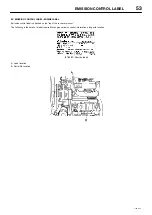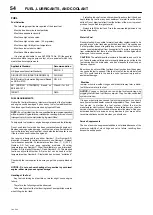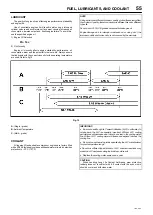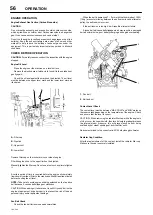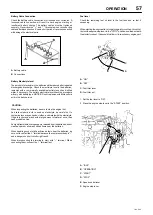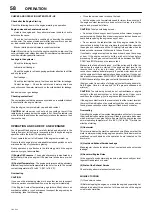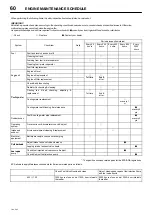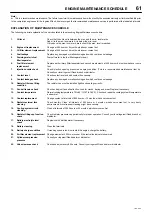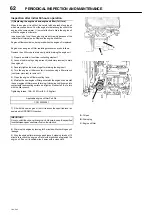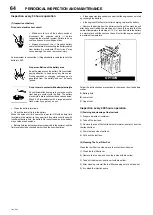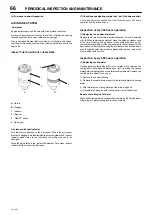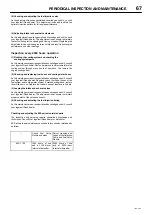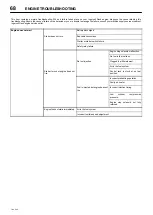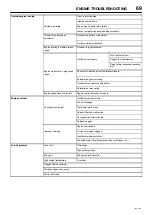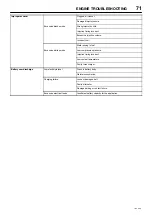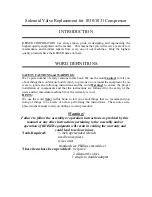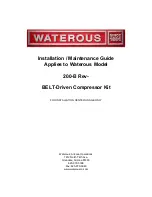
65
PERIODICAL INSPECTION AND MAINTENANCE
.
7/20, P65
C
D
A
B
A.
“OFF”
B.
“ON”
C.
Fuel filter lever
D.
Fuel filter pot
NOTE:
Entrance of dust and dirt can cause a malfunction of the fuel
injection pump and the injection nozzle. Wash the fuel filter cup
periodically.
Fuel System Air Bleeding
The entry of air into the fuel system will cause difficult engine starting
or engine malfunction.
When carrying out service procedures such as emptying the fuel tank,
draining the filter/separator, and changing the fuel filter element be sure
to bleed air from the fuel system.
To activate the “automatic air
−
bleeding system”, turn the key switch to
the “ON” position and energize the electromagnetic pump” to bleed the
air.
Air bleeding method
:
When the “starter switch” is set to the “ON” position to activate the
electromagnetic pump, fuel is forced to the fuel valve of each injection
pump and then to the leak
−
off pipe of each injector nozzle, so that any
air in the fuel system bleeds off automatically to the fuel tank.
NOTE:
Although the fuel system can bleed air automatically when the key
switch is in the “ON” position, air can also be manually bled by use of
the primer pump facility in the filter/separator assembly.
By unscrewing the plastic primer pump head ‘A’ and stroking it up and
down, any air bubbles in the system will be purged back to the fuel tank.
When this has been completed, the pump head must be screwed back
into the filter/separator assembly.
Start the engine and visually check the fuel system for leaks.
(3) Replacing the engine oil and engine oil filter (2nd time and
after)
Replace the engine oil every 200 hours operation from 2nd time and on.
Replace the engine oil filter at the same time.
(4) Checking and cleaning radiator fins.
Beware of dirt from air blowing
Wear
−
protective equipment such as goggles to
protect your eyes when blowing compressed air.
Dust or flying debris can hurt eyes.
Dirt and dust adhering on the radiator fins reduce the cooling
performance, causing overheating. Make it a rule to check the radiator
fins daily and clean as needed.
Blow off dirt and dust from fins and periphery with compressed air
[0.19MPa (2kgf/cm
2
)
or less] not to damage
the fins with compressed
air.
If
contaminated heavily, apply detergent, thoroughly clean and rinse
with tap water shower.
A.
Dust, dirt.
B.
Radiator fins
C.
Air blow
IMPORTANT:
Never use high pressure water or air from close by fins or never attempt
to clean using a wire brush. Radiator fins can be damaged.
(5) Checking the governor lever and accelerating device
.
The governor lever and accelerating devices (accelerating lever, pedal.
etc.) of the machine unit are connected by a fixed linkage to a
pneumatic actuator. If the linkage becomes loose, the deviation in the
position may result and make operation unsafe. Check the linkage
connections for excess play. For adjustment of linkage see
compressor operation section.
Governor Control Seals
As the governor is precisely adjusted, most of the controls are sealed,
please do not break them. Should any adjustment be necessary,
contact your local Ingersoll Rand branch or distributor.
NOTE:
Ingersoll Rand will not accept any warranty claim on an
engine with broken governor seals.



